Green Spaces in Urban Environments: Network Planning of Plant Species Composition
Abstract
1. Introduction
2. Literature Review
2.1. The Challenges of Urban Green Spaces
2.2. Factors in the Formation of the Assortment of Plant Species for the City
- (a)
- Type of climate and its corresponding temperatures, degree of moisture and prevailing types of air masses [19], which are habitual for the plant species. There are several options for defining climate zones. In addition to geography, the division of countries into regions, for each of which an assortment is defined, is taken into account for the planning of green spaces. In ornamental horticulture is also actively used the system USDA (United States Agriculture Department), where the division into climatic zones is tied to the minimum winter temperature [20].
- (b)
- Soil type. Anthropogenic factors are decisive for soil formation in urban areas. So, despite the fact that each city by its geographical location belongs to a certain climatic zone with a characteristic soil type, there is no possibility of using characteristic trees and shrubs. Urban soils are divided into three groups: natural undisturbed, natural disturbed and artificially created urban soils [21]. Due to the extremely small proportion of undisturbed soils on urban sites, in this research, we will consider artificially created urban soils, evaluated on the following parameters: acidity, fertility and soil type. The main sources of contamination of urban soils are roads, so plants resistant to soil contamination, as well as resistant to overconsolidation formed by constant vibration, are required for planting on adjacent sites.
- (c)
- Relation to light. According to their need for sunlight, plants are divided into conditional groups: heliophytes (light-loving) and sociophytes (shade-tolerant). Between them, sociogeliophytes are distinguished, by which they tolerate partial shading and can withstand untypical light regimes without harm. Lighting requirements may change with plants’ age as well as throughout the year. In groups of plants, this determines the distribution of species by tier as well as by light sides [22].
- (d)
- Relation to moisture. Plants can be classified according to their water requirements into the following categories: demanding plants (hygrophytes), which in natural conditions grow in excessively humid soils; moderately demanding (mesophytes), which grow in sufficiently humid places; and low-demanding (xerophytes), which prefer dry areas and can tolerate prolonged drought. According to limiting factors, plants are evaluated as resistant to temporary waterlogging and temporary soil desiccation.
- (e)
- Wind resistance. There are wind-tolerant plants, which are able to grow in open leeward spaces and are moderately resistant; and low-wind-tolerant, which are unable to grow in windy conditions due to the characteristics of the root system and wood.
- (f)
- Dust and gas resistance. Relation to air pollution PM and greenhouse gasses, e.g., CO2. Tree and shrub plants are generally divided into three categories in relation to air pollution: resistant, moderately resistant and unstable [23]. For urban sites, depending on the adjacency of roads with different loads, different types are required: at the boundary with the main multi-lane streets is required the use of exceptionally resistant species that are able to function safely and protect less resistant plants. As you move further away from the source of pollution, there is an opportunity to use more vulnerable species.
- (g)
- Disease resistance. Today, in the active international trade in tree and shrub seedlings, many new varieties are being introduced on city streets, but pests or fungal disease spores can also be carried along with them. Pathogens can also persist in the soil and in existing plantings. Disease control primarily requires the avoidance of single-species stands, timely mowing, and the use of “disease-resistant” varieties. Unfortunately, no species is resistant to all diseases, but you can select varieties that are resistant to already identified diseases.
- (h)
- Height of the plant, which can be regulated by both urban planning regulations [5] and the location of plants in the green space, to obtain the required level of insolation.
- (i)
- The diameter of the crown and root system. The size of the root system turns out to be the main limiting factor for the selection of plants in outdoor plantings and a secondary one for gardens and public gardens. Since the soil in the street is seriously compacted due to vibration and pressure, new plantings are actually forced to limit the growth of their root system to the diameter of the planting hole. For this reason, plants with a compact root system and correspondingly compact crowns are recommended for street planting.
- (a)
- Decorativeness. Despite the artistic and compositional value of all plants in the urban environment, they can also be divided into more or less decorative. According to ornamentality, plants can be divided into three main categories: basic—having a green coloring of leaves, as well as flowers and fruits; decorative— having bright coloring of leaves, as well as flowers, fruits, shaped leaves and fragrances; and strongly decorative—combining several features of ornamentality. Depending on the degree of human contact with plantings, plants with different ornamental qualities are used in different plantings. In the garden, basic plants; for the outer perimeter, ornamental for most of the plantings and strongly decorative next to paths and composition nodes; in the square and boulevard, basic and decorative.
- (b)
- Role in urban composition. The main types of organization of tree and shrub vegetation on the site include tree arrays; groups of trees and shrubs; solitary plants (solitaries); alleys; bossets and hedges; elements of vertical landscaping; street plantings; lawns; and flower compositions. In world practice, there are trends towards the use of complexly composed tree and shrub groups on city streets, which allow for the diversification of the urban environment [24].
2.2.1. Factors of Interrelationship and Combination of Plant Species
- (a)
- Growing conditions. The basic basis for combining plant species into groups is the identical growing conditions of plants, which are expressed in similar requirements for soil composition, climate, light and moisture [25].
- (b)
- The conditions of the combination of plant species due to the peculiarities of the joint growth of plants, which can be characterized by competition for resources or the successful coexistence of species. For example, certain plants cannot exist close to each other, while others increase their resistance to disease. This phenomenon is called allelopathy [26], a property of some organisms to secrete chemical compounds that inhibit or suppress the development of others. Allelopathy is also sometimes understood as both negative and positive interactions between plants in phytocenoses. Disease of plant species by diseases, viruses and pathogens depends mainly on the state of plant “immunity”, but we cannot exclude the factor of epidemics and wave pandemics, the development and spread of which is worth studying, supplementing the matrix of plant species interaction. For example, the spread of Elm borer, which as a pest is not at all dangerous to elm, but as a vector of fungal disease—Dutch elm disease—has destroyed by wave spread the entire middle belt of Russia and is spreading the disease already in Karelia [27].
- (c)
- Features of the accepted practices of landscaping in the region, in accordance with which in the city can be developed precedents for combinations of plant species, well proven in similar conditions.
- (d)
- Compositional features due to the intended function of planting. So, for ornamental purposes, there are stable combinations of species that proved themselves well. It should be noted that the above factors are interdependent, and this should be taken into account in the planning of plant assortments. For example, ecologo-biological factors are most often related to compositional factors due to the fact that ornamental properties are lower in more hardy plants. In particular, plants adapted to life with low light need less care: moisture evaporates more slowly, and they need fewer nutrients and grow more slowly. They are less likely to have bright, lush colors than light-loving plants.
2.2.2. Factors of Species Invasiveness
- (a)
- Transformers—actively invade natural and semi-natural communities; plants change their appearance and disrupt successional relationships.
- (b)
- Non-native—actively settling and naturalizing in disturbed semi-natural and natural habitats.
- (c)
- Species that disperse and naturalize in disturbed habitats—during further naturalization, some of them may establish themselves in natural and semi-natural plant communities.
- (d)
- Potentially invasive species—capable of regenerating in introduced habitats and have shown themselves to be invasive species in adjacent regions. There are many problem areas where cultivated species are impossible or extremely laborious, and the need and necessity for greening is high. Invasive species can act as a tool to increase the volumetric indicators of greening the territory [29,30].
2.3. Methods for Modeling Plant Species Composition for Green Spaces
2.4. Network Analysis
3. Plant Species Composition Modeling
3.1. Creating a Base of Plant Species, Taking into Account the Factors of Growth
3.2. Modeling Plant Species Interrelationships and Combinations
3.3. Modeling Urban Greening Precedents in the Region
4. Adaptation of Plant Species Composition Planning
4.1. Preparing the Data for the Landscaping Area
4.2. Selecting and Setting Up the Algorithm for Generating the Recommended Sustainable Plant Species Assortments
- (a)
- The number of negative interactions between plant species should be minimal or absent.
- (b)
- The compositions shall include as many combinations of plant species as possible in order to maintain diversity in the emerging system.
- (c)
- The compositions should grow on the same soil types, bearing in mind that urban soils tend to form directly under the planned range of greenery.
4.3. Generation of Final Assortments Based on the Modularity Maximization Algorithm
5. Discussion
6. Conclusions
Author Contributions
Funding
Institutional Review Board Statement
Informed Consent Statement
Data Availability Statement
Conflicts of Interest
References
- Yang, T.; Barnett, R.; Fan, Y.; Li, L. The effect of urban green space on uncertainty stress and life stress: A nationwide study of university students in China. Health Place 2019, 59, 102199. [Google Scholar] [CrossRef] [PubMed]
- Shmelev, S. (Ed.) Sustainable Cities Reimagined: Multidimensional Assessment And Smart Solutions; Routledge: Abingdon, UK, 2019. [Google Scholar]
- Berrone, P.; Ricart, J.E.; Duch, A.; Carrasco, C. IESE cities in motion index 2019. IESE 2019, 5, 2019. [Google Scholar]
- European Green Leaf Award. Applying for EU Green Leaf Award. Available online: https://environment.ec.europa.eu/topics/urban-environment/european-green-leaf-award/applying-eu-green-leaf-award_en (accessed on 24 March 2023).
- SNiP 2.07.01-89* Urban Planning. Planning and Development of Urban and Rural Settlements. Available online: https://www.minstroyrf.gov.ru/docs/14465/ (accessed on 23 March 2023).
- Paithankar, D.N.; Taji, S.G. Investigating the hydrological performance of green roofs using storm water management model. Mater. Today Proc. 2020, 32, 943–950. [Google Scholar] [CrossRef]
- Zhang, B.; Cao, D.; Zhu, S. Use of plants to clean polluted air: A potentially effective and low-cost phytoremediation technology. BioResources 2020, 15, 4650–4654. [Google Scholar] [CrossRef]
- Nowak, D.J.; Hoehn, R.; Crane, D.E. Oxygen production by urban trees in the United States. Arboric. Urban For. 2007, 33, 220. [Google Scholar] [CrossRef]
- Moseley, D.; Marzano, M.; Chetcuti, J.; Watts, K. Green networks for people: Application of a functional approach to support the planning and management of greenspace. Landsc. Urban Plan. 2013, 116, 1–12. [Google Scholar] [CrossRef]
- Ahern, J. Green infrastructure for cities: The spatial dimension. Cities Futur. Towards Integr. Sustain. Water Landsc. Manag. 2007, 13, 267–283. [Google Scholar]
- Bolund, P.; Hunhammar, S. Ecosystem services in urban areas. Ecol. Econ. 1999, 29, 293–301. [Google Scholar] [CrossRef]
- Shmelev, S.E.; Shmeleva, I.A. Sustainable cities: Problems of integrated interdisciplinary research. Int. J. Sustain. Dev. 2009, 12, 4–23. [Google Scholar] [CrossRef]
- Gülgün, B.; Güney, M.; Aktaş, E.; Yazici, K. Role of the landscape architecture in interdisciplinary planning of sustainable cities. J. Environ. Protec. Ecol. 2014, 15, 1877–1880. [Google Scholar]
- McPherson, E.G. Accounting for benefits and costs of urban greenspace. Landsc. Urban Plan. 1992, 22, 41–51. [Google Scholar] [CrossRef]
- Mertens, E.; Stiles, R.; Karadeniz, N. Green May Be Nice, but Infrastructure Is Necessary. Land 2022, 11, 89. [Google Scholar] [CrossRef]
- Ambrey, C.; Baker, D.; Byrne, J.; Matthews, T. What Is Green Infrastructure, and How Do We Include It in Urban Planning?—Future of Construction; Springer: Berlin/Heidelberg, Germany, 2016. [Google Scholar]
- Asgarzadeh, M.; Vahdati, K.; Lotfi, M.; Arab, M.; Babaei, A.; Naderi, F.; Soufi, M.P.; Rouhani, G. Plant selection method for urban landscapes of semi-arid cities (a case study of Tehran). Urban For. Urban Green. 2014, 13, 450–458. [Google Scholar] [CrossRef]
- Leishman, M.R.; Thomson, V.P.; Cooke, J. Native and exotic invasive plants have fundamentally similar carbon capture strategies. J. Ecol. 2010, 98, 28–42. [Google Scholar] [CrossRef]
- Air Masses and Atmospheric Fronts. Available online: http://meteocenter.net/meteolib/vm.htm (accessed on 27 March 2023).
- USDA Plant Hardiness Zone Map. Available online: https://planthardiness.ars.usda.gov/ (accessed on 27 March 2023).
- Trigub, V. Urban Soils as a Special Type of Soil. Sci. Notes Crime. Fed. Univ. Named Vernadsky. Geogr. Geol. 2011, 24, 321–325. [Google Scholar]
- Light-Loving and Shade-Tolerant Plants. Available online: http://www.treefolium.ru/articles/svetolyubivye-tenevynoslivye-rasteniya/ (accessed on 27 March 2023).
- Nikolayevsky, V.S. Biological Bases of Plant Gas Resistance; Siberian Division: Novosibirsk, Russia, 1979. [Google Scholar]
- Hitchmough, J.D. New approaches to ecologically based, designed urban plant communities in Britain: Do these have any relevance in the United States? Cities Environ. 2008, 1, 10. [Google Scholar] [CrossRef]
- Dong-sheng, G.; Yu-juan, C. Status of urban vegetation in Guangzhou City. J. For. Res. 2003, 14, 249–252. [Google Scholar] [CrossRef]
- Shirgapure, K.; Ghosh, P. Allelopathy a tool for sustainable weed management. Arch. Curr. Res. Int. 2020, 20, 17–25. [Google Scholar] [CrossRef]
- Kumar, M.; Garkoti, S.C. Allelopathy effects of invasive alien Ageratina adenophora on native shrub species of chir pine forest in the central Himalaya, India. J. For. Res. 2022, 27, 53–62. [Google Scholar] [CrossRef]
- Corina Pindaru, L.; Razvan Nita, M. Methods of Including Invasive Species Research in Urban Planning—A Case Study on Ailanthus altissima. Pol. J. Environ. Stud. 2023, 32, 689–704. [Google Scholar] [CrossRef]
- Potgieter, L.J.; Shrestha, N.; Cadotte, M.W. Prioritizing terrestrial invasive alien plant species for management in urban ecosystems. J. Appl. Ecol. 2022, 59, 872–883. [Google Scholar] [CrossRef]
- Davidson, A.M.; Jennions, M.; Nicotra, A.B. Do invasive species show higher phenotypic plasticity than native species and, if so, is it adaptive? A meta-analysis. Ecol. Lett. 2011, 14, 419–431. [Google Scholar] [CrossRef] [PubMed]
- Godefroid, S.; Koedam, N. Urban plant species patterns are highly driven by density and function of built-up areas. Landsc. Ecol. 2007, 22, 1227–1239. [Google Scholar] [CrossRef]
- Talal, M.L.; Santelmann, M.V. Plant community composition and biodiversity patterns in urban parks of Portland, Oregon. Front. Ecol. Evol. 2019, 7, 201. [Google Scholar] [CrossRef]
- Chang, C.R.; Chen, M.C.; Su, M.H. Natural versus human drivers of plant diversity in urban parks and the anthropogenic species-area hypotheses. Landsc. Urban Plan. 2021, 208, 104023. [Google Scholar] [CrossRef]
- Ramirez, K.S.; Geisen, S.; Morriën, E.; Snoek, B.L.; van der Putten, W.H. Network analyses can advance above-belowground ecology. Trends Plant Sci. 2018, 23, 759–768. [Google Scholar] [CrossRef]
- Majdi, N.; Hette-Tronquart, N.; Auclair, E.; Bec, A.; Chouvelon, T.; Cognie, B.; Danger, M.; Decottignies, P.; Dessier, A.; Desvilettes, C.; et al. There’s no harm in having too much: A comprehensive toolbox of methods in trophic ecology. Food Webs 2018, 17, e00100. [Google Scholar] [CrossRef][Green Version]
- Shmeleva, I.A.; Shmelev, S.E. Climate Change Discourse Analysis: The Russian Case. In Sustainability Analysis; Springer: Berlin/Heidelberg, Germany, 2012; pp. 203–253. [Google Scholar]
- Barberán, A.; Bates, S.T.; Casamayor, E.O.; Fierer, N. Using network analysis to explore co-occurrence patterns in soil microbial communities. Isme J. 2012, 6, 343–351. [Google Scholar] [CrossRef]
- Encinas-Viso, F.; Alonso, D.; Klironomos, J.N.; Etienne, R.S.; Chang, E.R. Plant–mycorrhizal fungus co-occurrence network lacks substantial structure. Oikos 2016, 125, 457–467. [Google Scholar] [CrossRef]
- Baiser, B.; Elhesha, R.; Kahveci, T. Motifs in the assembly of food web networks. Oikos 2016, 125, 480–491. [Google Scholar] [CrossRef]
- Cai, W.; Snyder, J.; Hastings, A.; D’Souza, R.M. Mutualistic networks emerging from adaptive niche-based interactions. Nat. Commun. 2020, 11, 5470. [Google Scholar] [CrossRef] [PubMed]
- Ponisio, L.C.; Valdovinos, F.S.; Allhoff, K.T.; Gaiarsa, M.P.; Barner, A.; Guimarães Jr, P.R.; Hembry, D.H.; Morrison, B.; Gillespie, R. A network perspective for community assembly. Front. Ecol. Evol. 2019, 7, 103. [Google Scholar] [CrossRef]
- Sargent, R.D.; Ackerly, D.D. Plant–pollinator interactions and the assembly of plant communities. Trends Ecol. Evol. 2008, 23, 123–130. [Google Scholar] [CrossRef]
- Campbell, C.; Yang, S.; Albert, R.; Shea, K. A network model for plant–pollinator community assembly. Proc. Natl. Acad. Sci. USA 2011, 108, 197–202. [Google Scholar] [CrossRef] [PubMed]
- Blüthgen, N. Why network analysis is often disconnected from community ecology: A critique and an ecologist’s guide. Basic Appl. Ecol. 2010, 11, 185–195. [Google Scholar] [CrossRef]
- Singh, G.; Papoutsoglou, E.A.; Keijts-Lalleman, F.; Vencheva, B.; Rice, M.; Visser, R.G.; Bachem, C.W.; Finkers, R. Extracting knowledge networks from plant scientific literature: Potato tuber flesh color as an exemplary trait. BMC Plant Biol. 2021, 21, 1–14. [Google Scholar] [CrossRef]
- Online Plant Identifier. Available online: https://www.plantarium.ru (accessed on 27 March 2023).
- The World Flora Online. Available online: http://www.worldfloraonline.org (accessed on 27 March 2023).
- Savvateev Nursery. Available online: https://www.drevo-spas.ru (accessed on 27 March 2023).
- Sale of Plants Landscape Design. Available online: https://www.martin-sad.ru (accessed on 27 March 2023).
- Lorberg Plant Nursery. Available online: https://www.lorberg.com/de/ (accessed on 27 March 2023).
- Plant Database. Available online: https://github.com/iduprojects/PlantCompositionPlanning/tree/main/backend (accessed on 27 March 2023).
- PlantCompositionPlanning Graphs. Available online: https://github.com/iduprojects/PlantCompositionPlanning/blob/main/graphs/combined_graph.gexf (accessed on 25 March 2023).
- Zhu, J.; Chen, B.; Zeng, Y. Community detection based on modularity and k-plexes. Inf. Sci. 2020, 513, 127–142. [Google Scholar] [CrossRef]
- Network Analysis in Python. Available online: https://networkx.org (accessed on 24 March 2023).
- Newman, M.E. Equivalence between modularity optimization and maximum likelihood methods for community detection. Phys. Rev. E 2016, 94, 052315. [Google Scholar] [CrossRef]
- PlantCompositionPlanning. Available online: https://github.com/iduprojects/PlantCompositionPlanning (accessed on 25 March 2023).
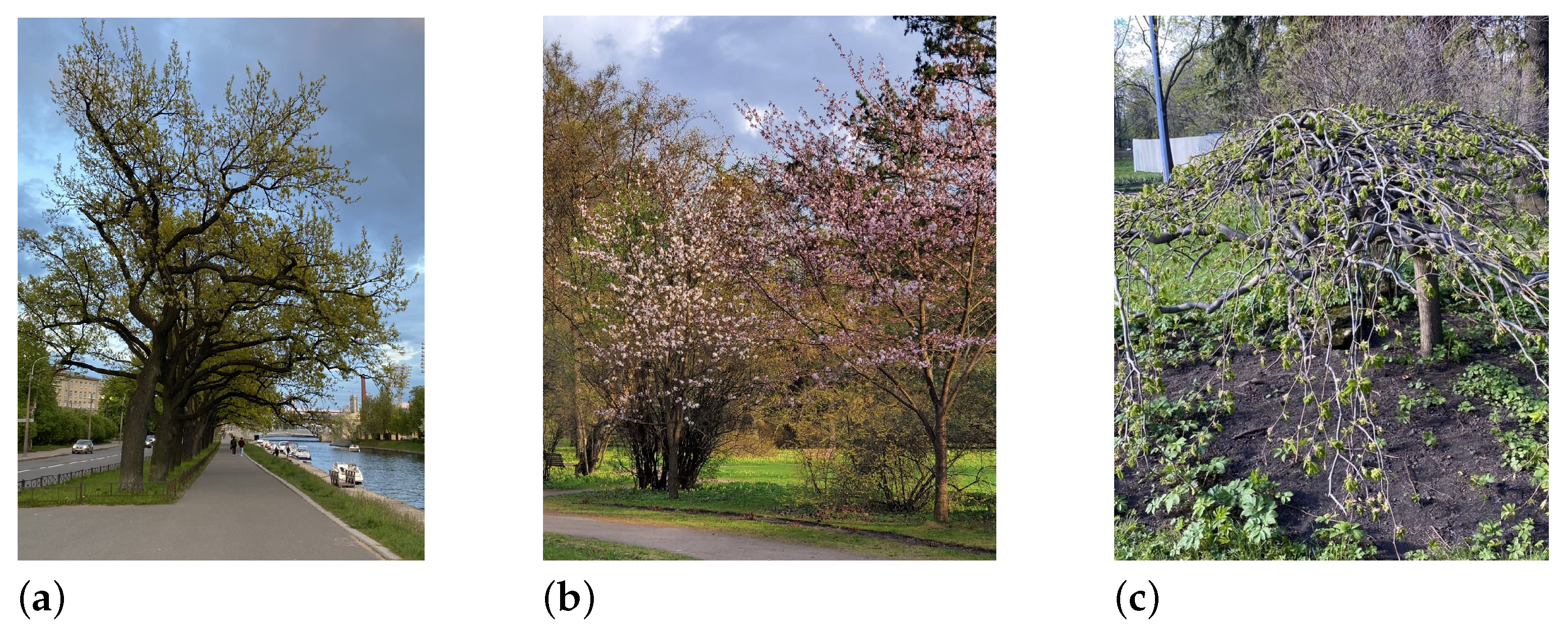
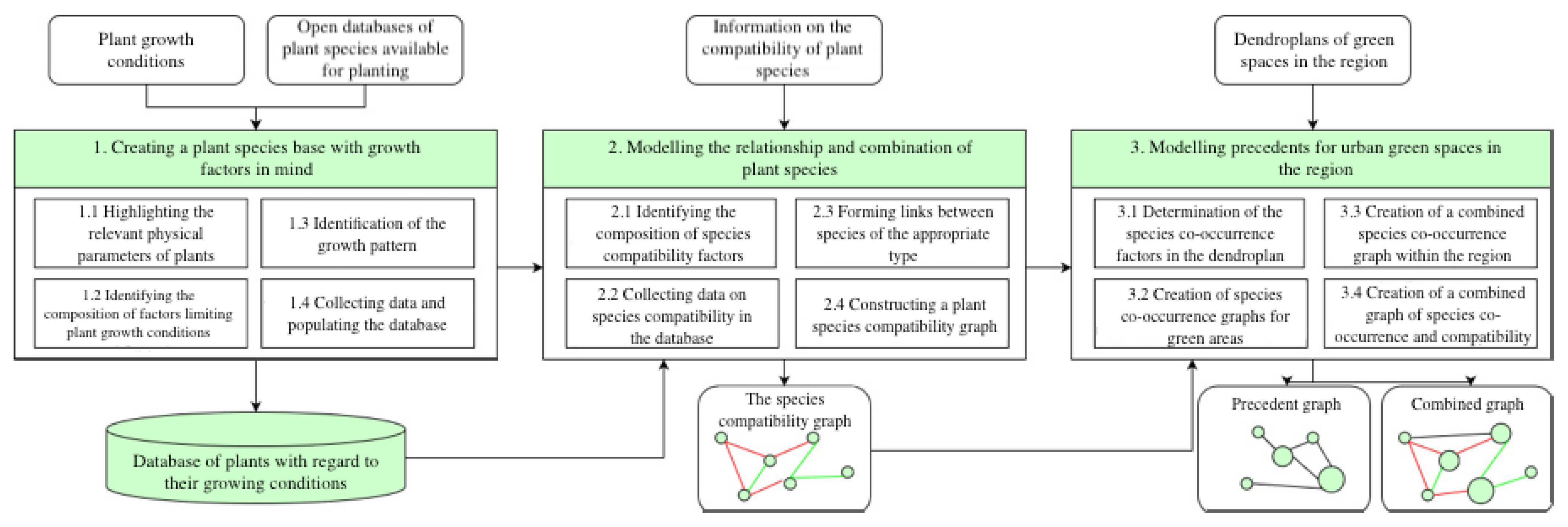
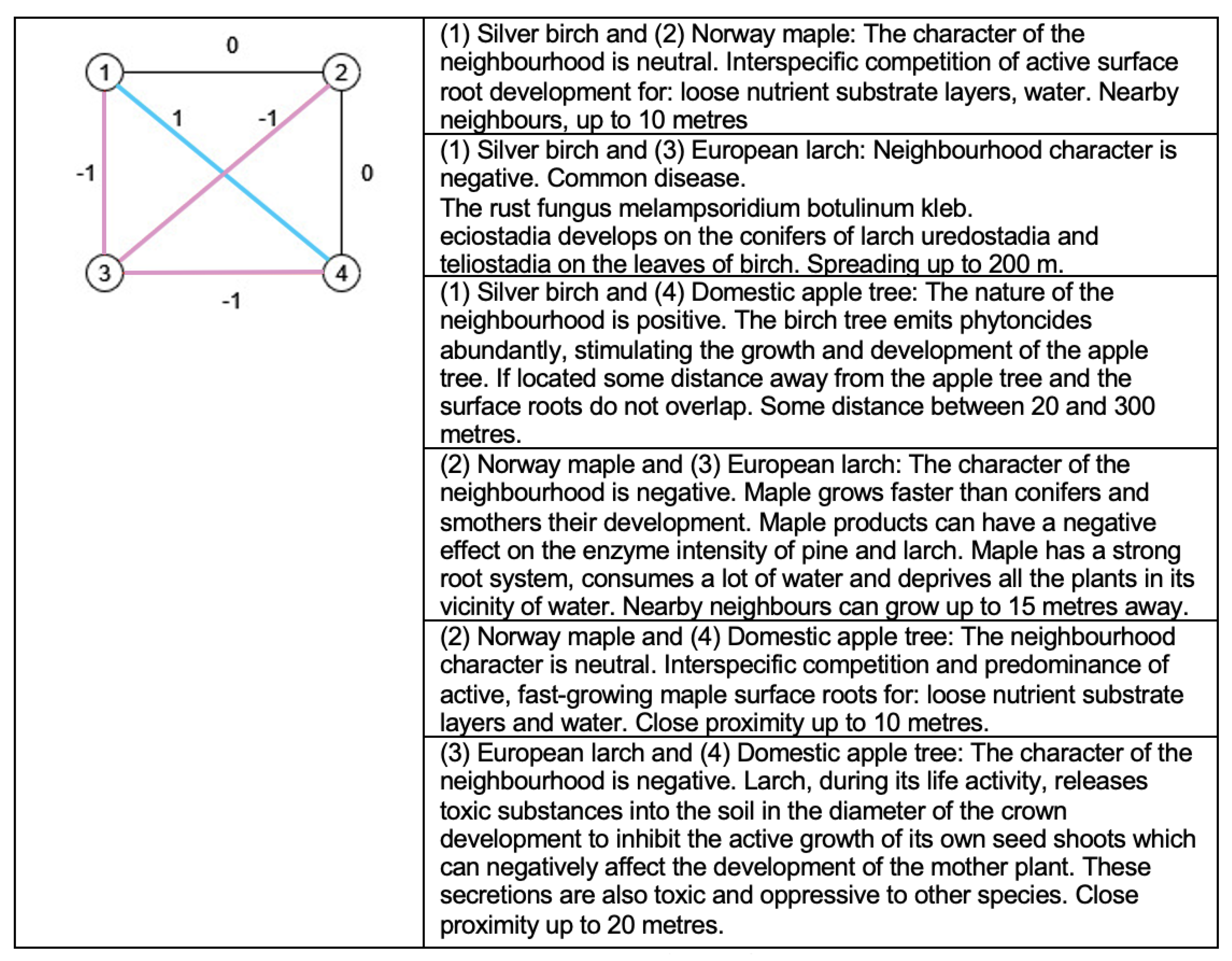
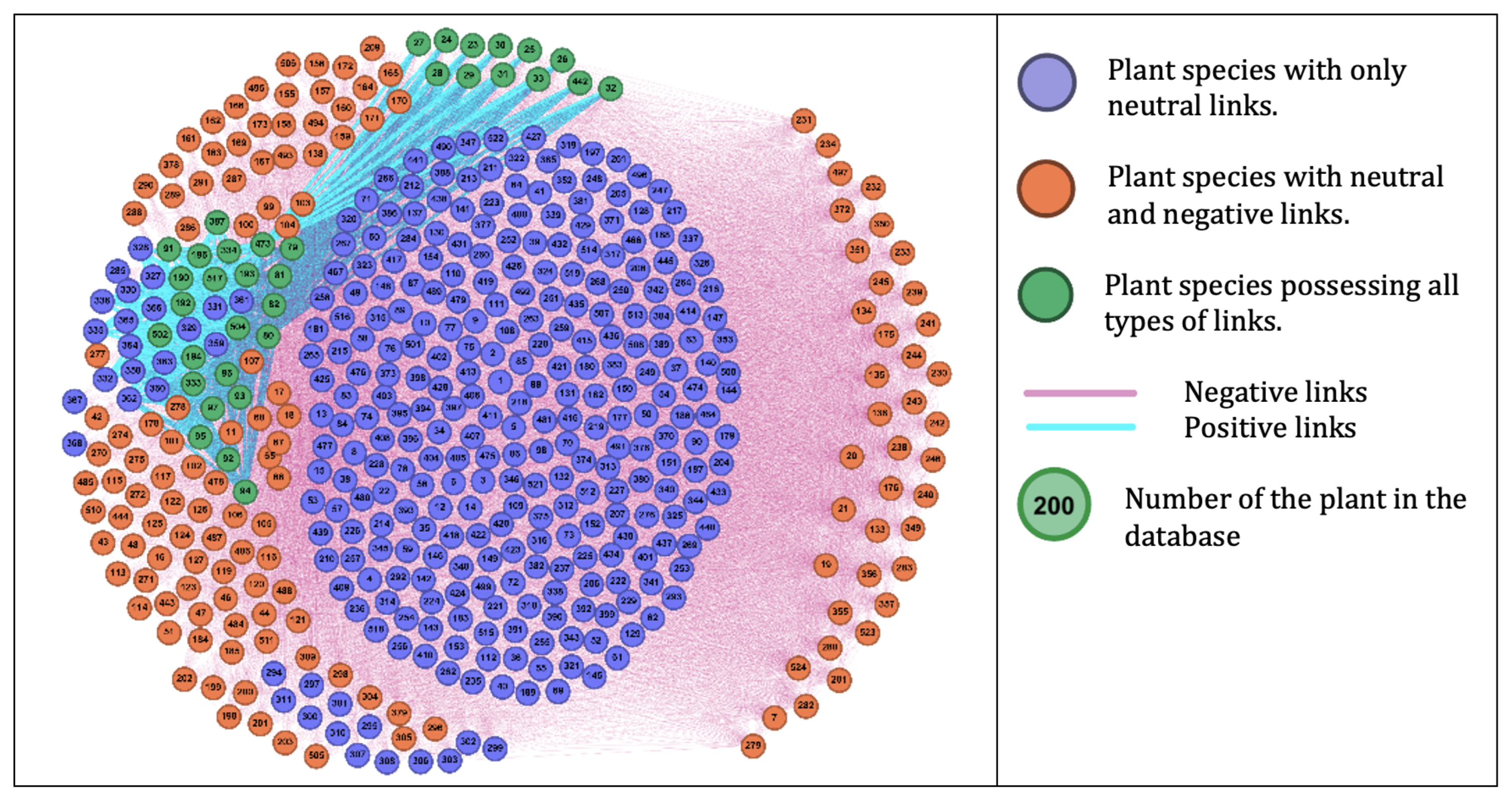
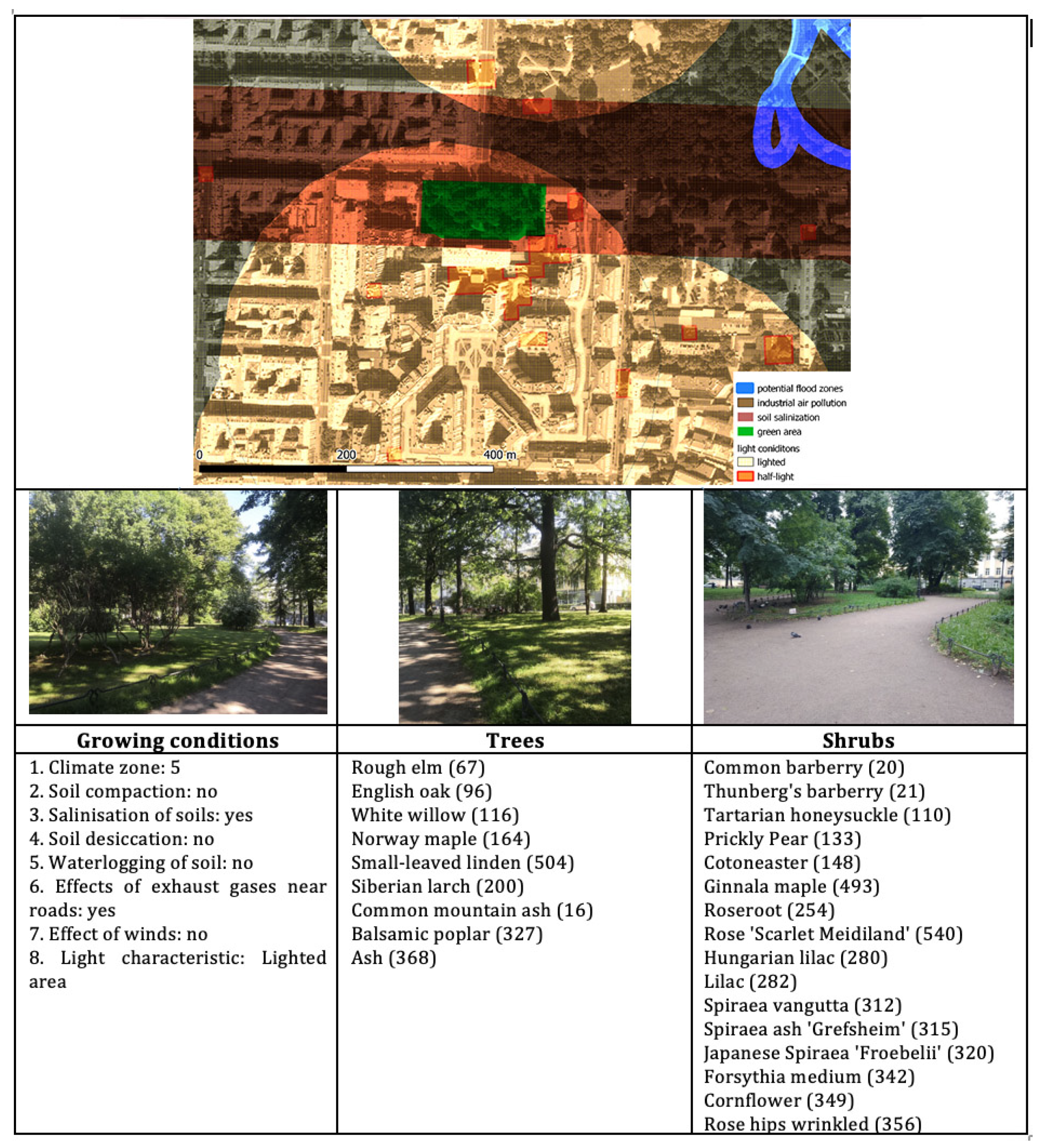
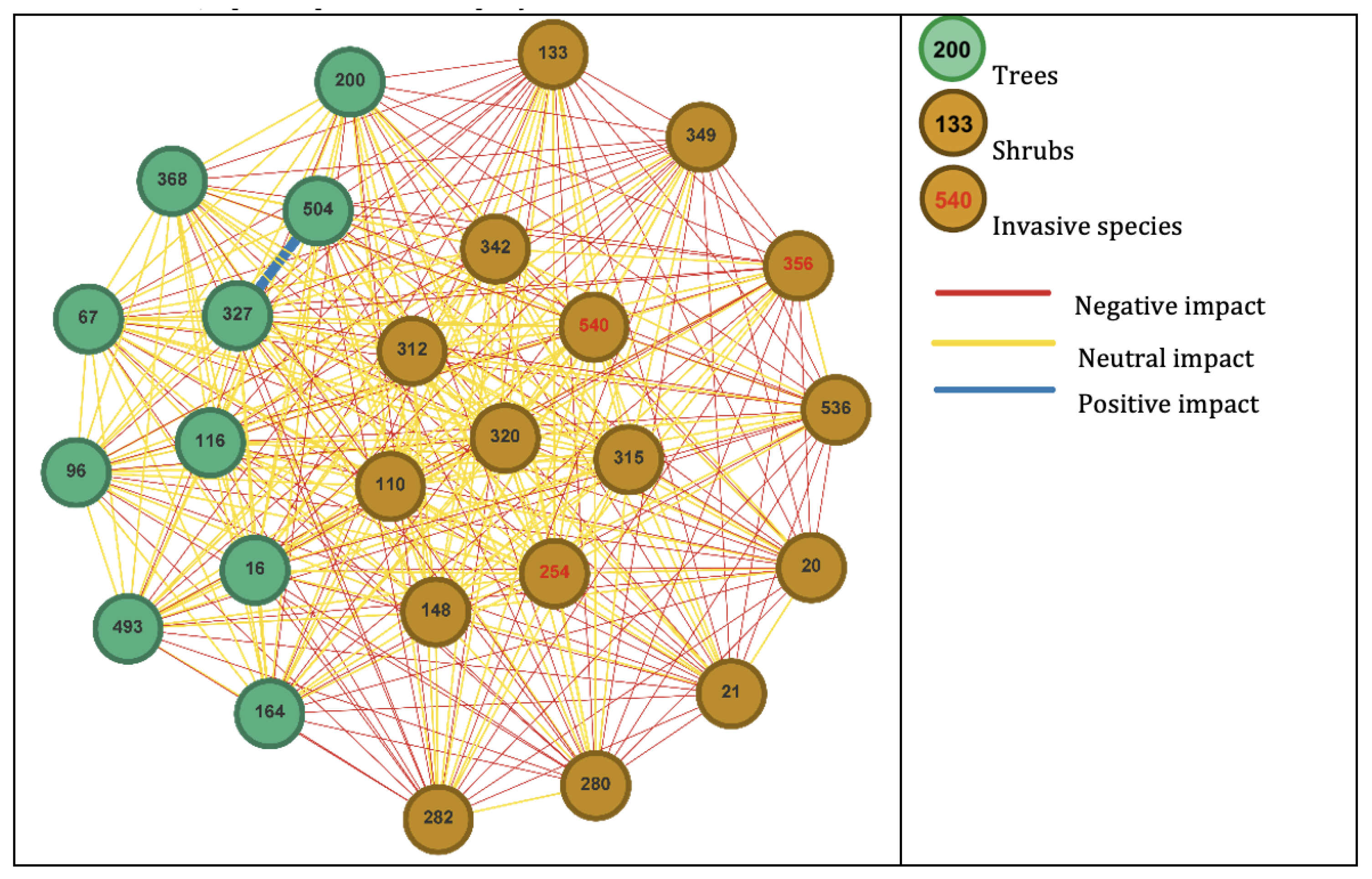
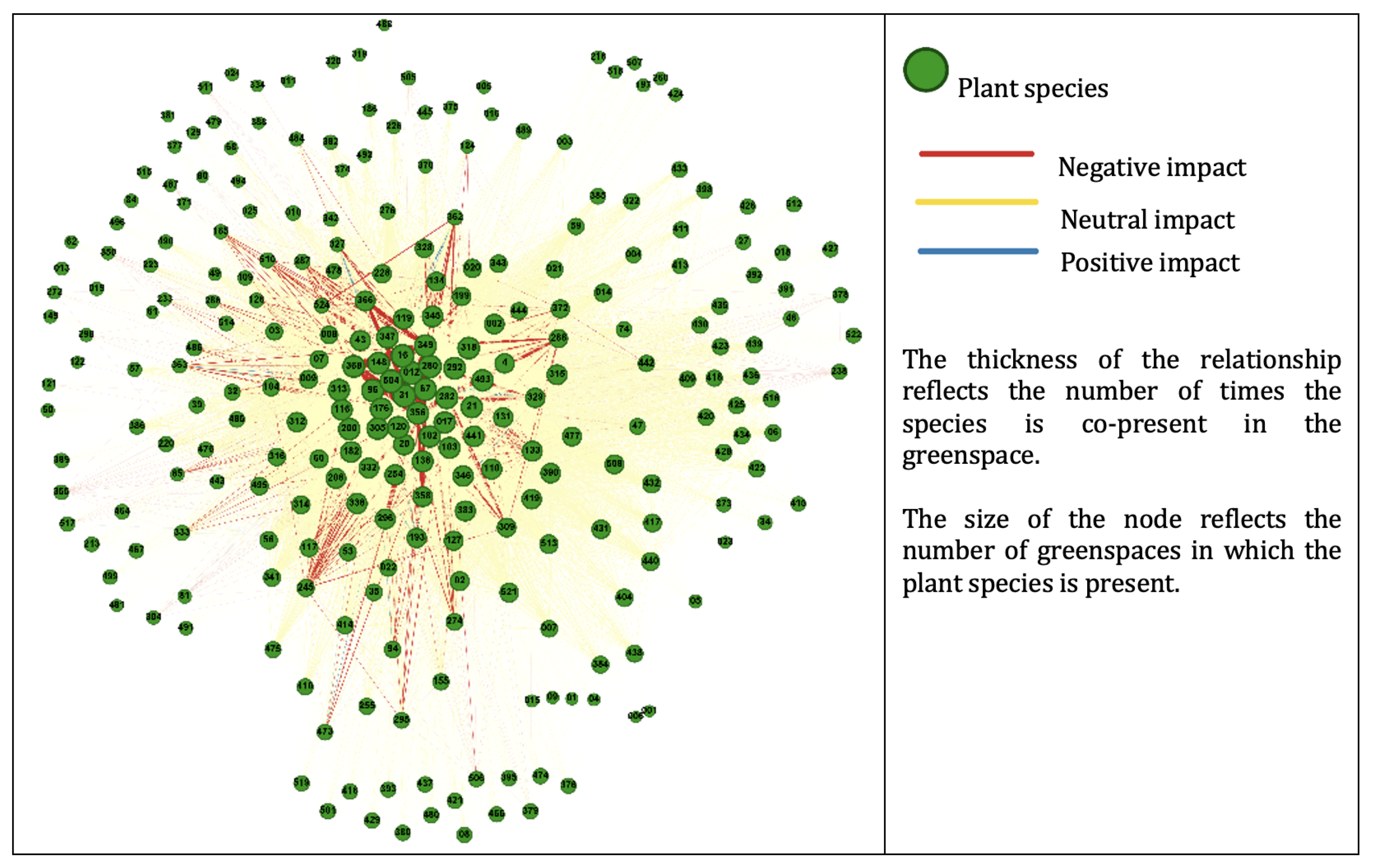

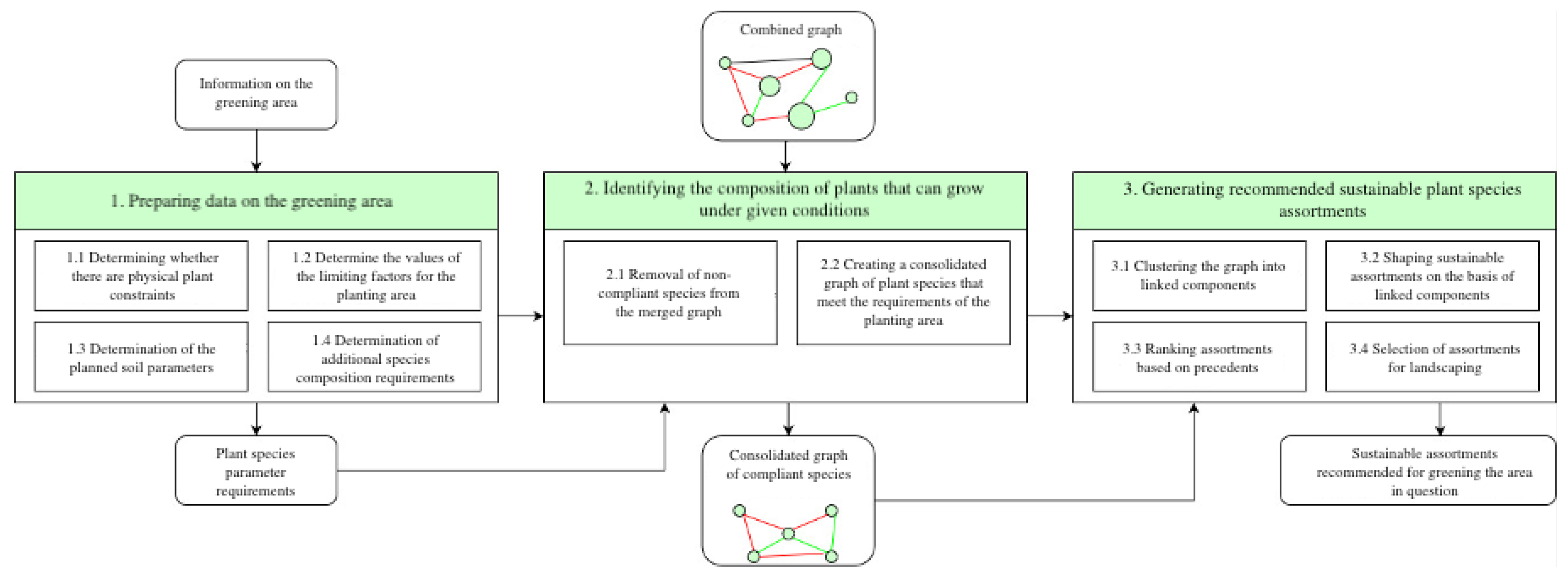
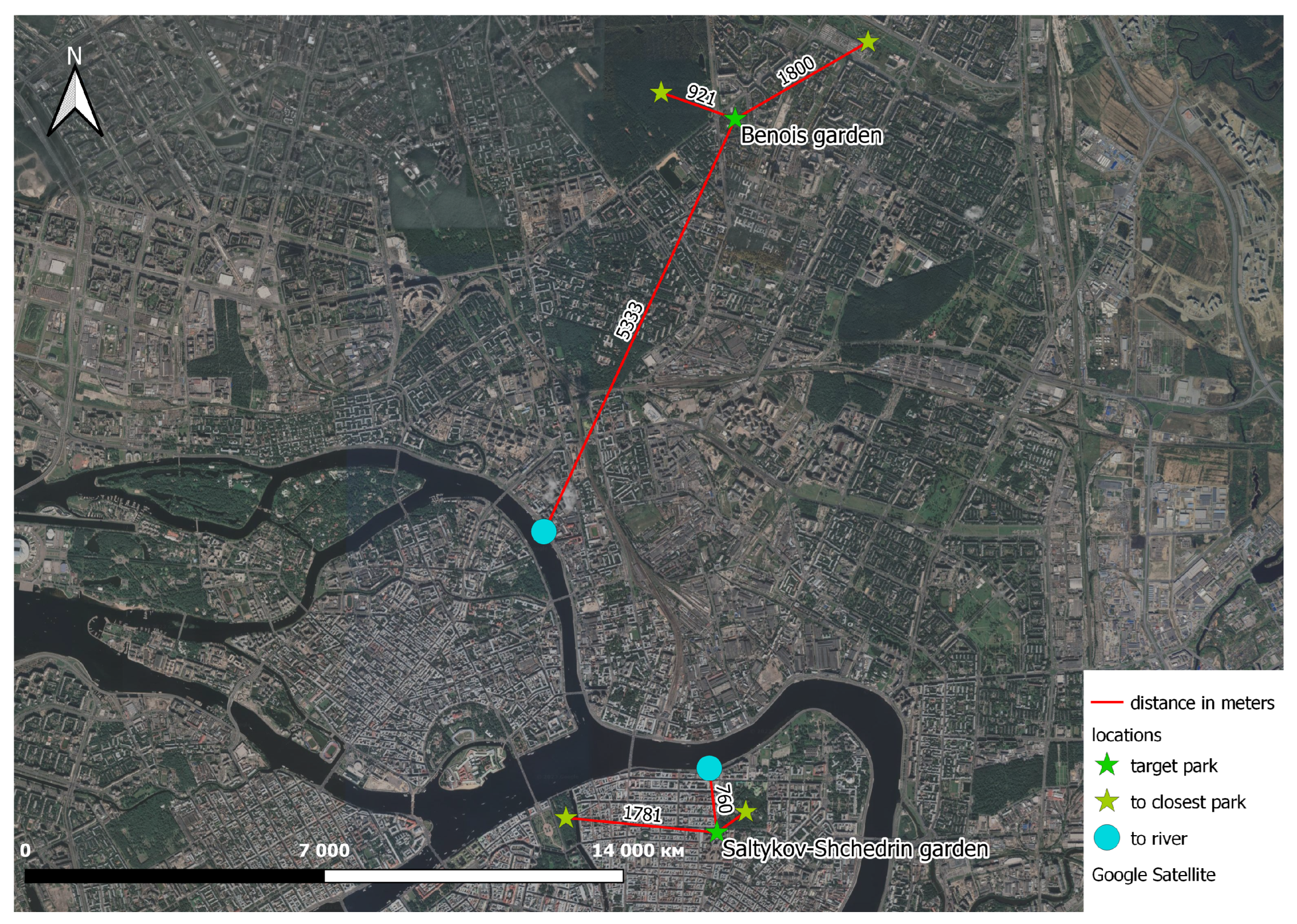

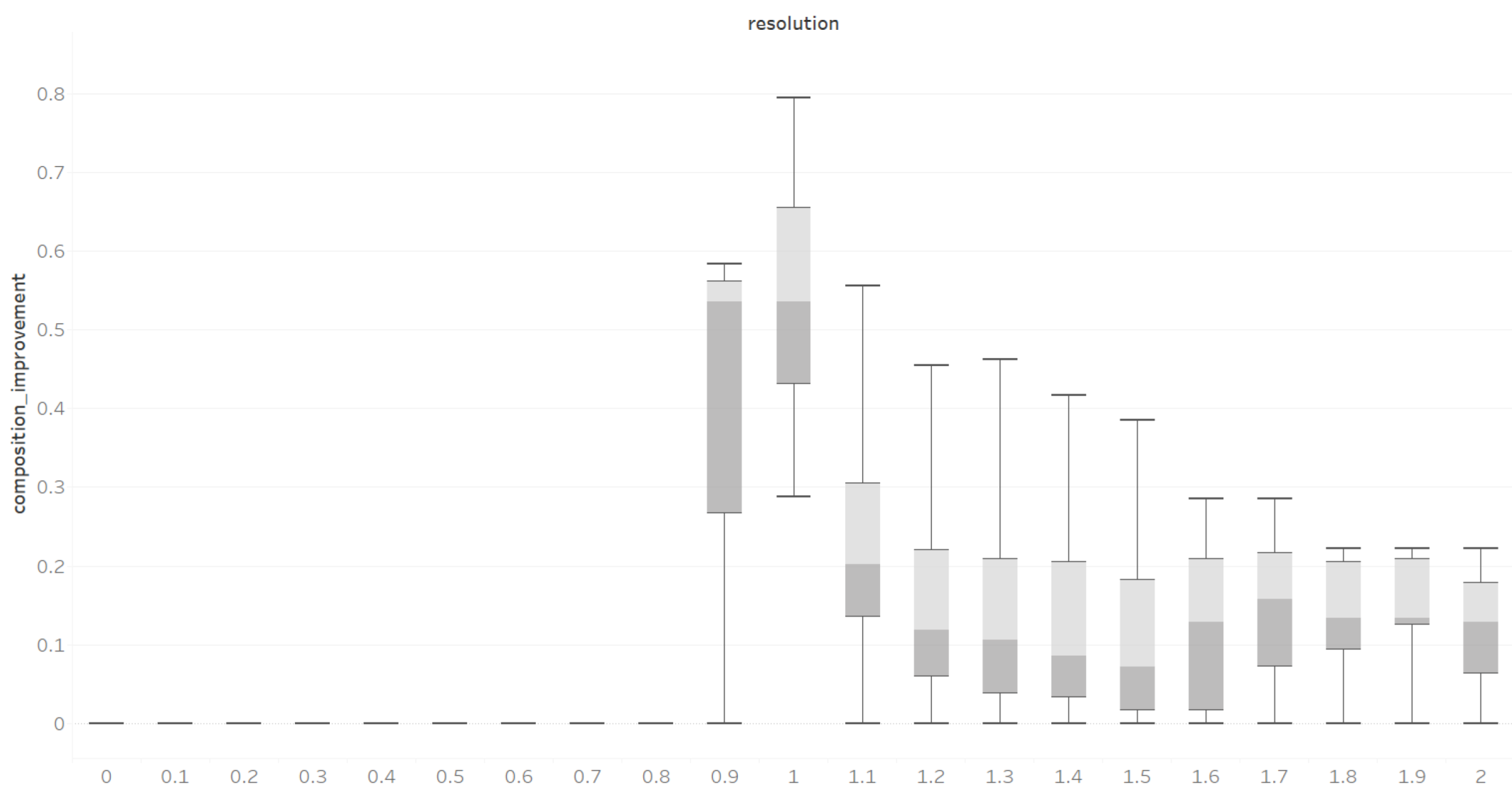
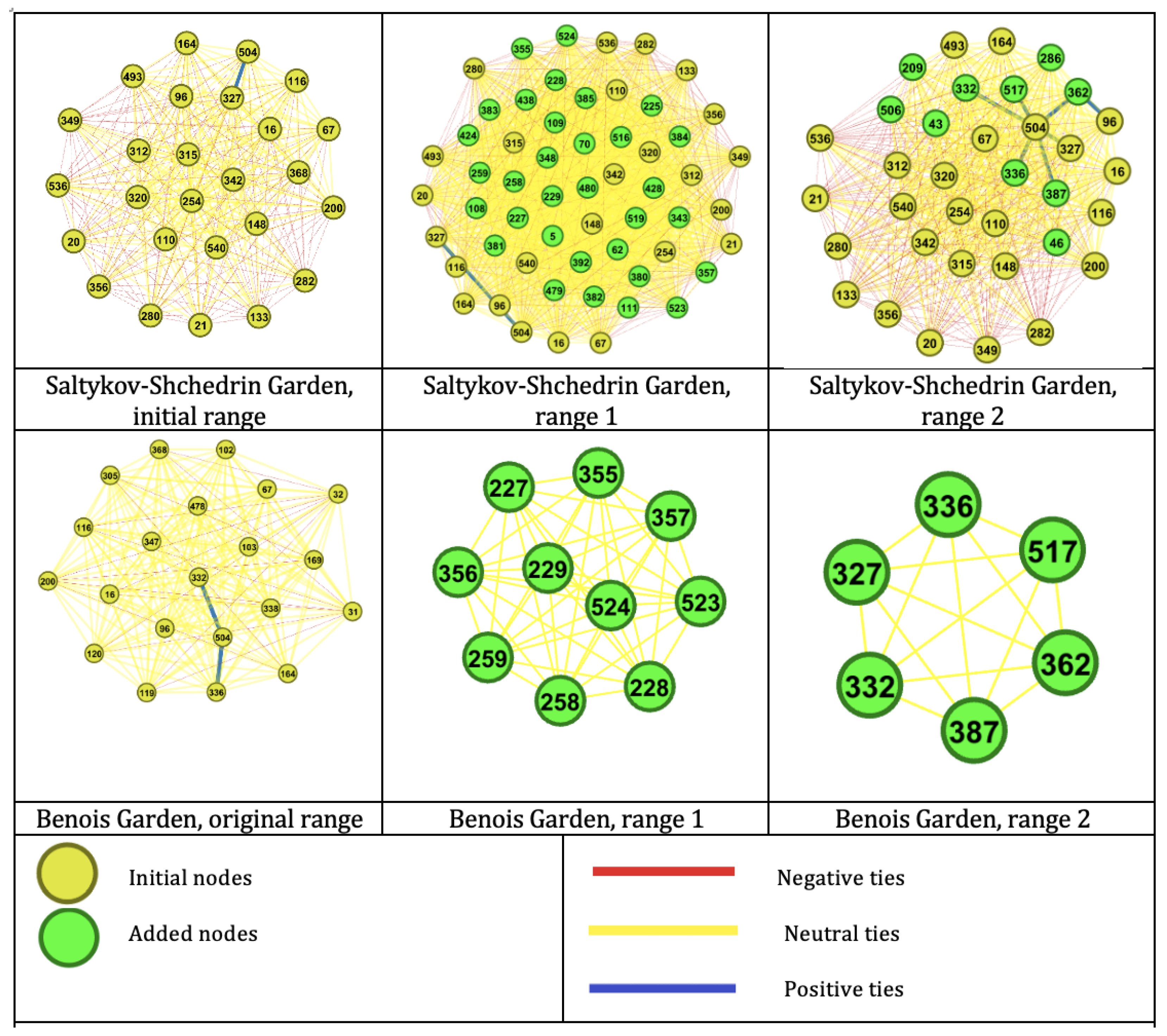
| Designation | Parameter | Value Range | Description |
|---|---|---|---|
| 1. Physical parameters of plants (P) | |||
| P1 | Crown size | Meters | Average diameter of the crown of an adult plant |
| P2 | Height | Meters | Average adult plant |
| 2. Limiting factors (F) | |||
| F1 | USDA Climate Zone | Number of zone (1–8) | Each zone is defined by temperature readings |
| F2 | Relation to overcompaction of soil | ‘1’—carries ‘0’—can tolerate ‘−1’—does not tolerate | Resistance of plant species to growing in soils subject to compaction due to active movement of people |
| F3 | Relation to soil salinization | ‘1’—carries ‘0’—can tolerate ‘−1’—does not tolerate | Resistance of plant species to growing in soils prone to pollution, excessive salt content near roads treated with chemicals |
| F4 | Relation to soil desiccation | ‘1’—carries ‘0’—can tolerate ‘−1’—does not tolerate | Resistance of plant species to growing in soils whose temporary condition may be waterless and arid |
| F5 | Resistance to waterlogging | ‘1’—carries ‘0’—can tolerate ‘−1’—does not tolerate | Resistance of plant species to growing in soils subject to temporary or spontaneous retention of large quantities of water in their composition |
| F6 | Smoke and gas resistance | ‘1’—carries ‘0’—can tolerate ‘−1’—does not tolerate | The ability of a plant to survive in conditions of maximum air pollution |
| F7 | Wind resistance | ‘1’—carries ‘0’—can tolerate ‘−1’—does not tolerate | Ability to stay in open leeward spaces |
| F8 | Environmental group in relation to moisture | 1—xerophytes 2—mesophytes 3—hygrophytes | - |
| 3. Soil parameters (S) | |||
| S1 | Soil acidity | ‘1’—prefers ‘0’—can tolerate ‘−1’—does not tolerate | Plant’s attitude to different acidic compositions of soils: strongly acidic, acidic, weakly acidic, neutral, weakly alkaline, alkaline, strongly alkaline |
| S2 | Soil fertility | ‘1’—prefers ‘0’—can tolerate ‘−1’—does not tolerate | Plant’s relationship to soil fertility: fertile, medium fertile, poor |
| S3 | Mechanical composition of soil | ‘1’—prefers ‘0’—can tolerate ‘−1’—does not tolerate | Relation of the plant to the type of soil: sandy, sandy loam, loam, clay, stony, rubbly, heavy, well-drained |
| 4. Propagation intensity parameters (I) | |||
| I1 | Aggressiveness of plant growth | ‘1’—high ‘0’—medium ‘−1’—low | How actively the plant is able to spread under normal growing conditions |
| I2 | Vitality | ‘1’—high ‘0’—medium ‘−1’—low | The ability of the plant to recover from pruning, damage, fractures |
| I3 | Invasive | 1—is invasive 0—is not | - |
| 5. Parameters of light conditions (L) | |||
| L1 | Relation to light | ‘1’—prefers ‘0’—can tolerate ‘−1’—does not tolerate | The ability of the plant to grow in varying degrees of light in places with full light, penumbra, shaded areas. |
| Parameters | Silver Birch | Norway Maple | European Larch | Domestic Apple Tree |
|---|---|---|---|---|
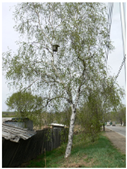 | 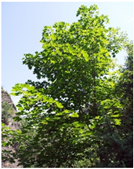 | 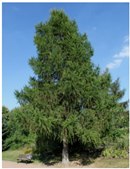 |  | |
| Latin name: | Betula pendula Roth | Acer platanoides L. | Larix decidua Mill | Malus domestica (Suckow) Borkh |
| Crown size | 7 m | 15 m | 12 m | 3 m |
| Height | 20 m | 30 m | 25 m | 5 m |
| USDA Climate zone | 3 | 4 | 3 | 4 |
| Relation to overcompaction of soil | −1 | −1 | −1 | 0 |
| Relation to soil salinization | −1 | −1 | 0 | −1 |
| Relation to soil desiccation | 1 | 0 | −1 | 1 |
| Resistance to waterlogging | 1 | −1 | −1 | −1 |
| Smoke and gas resistance | −1 | 1 | 1 | 1 |
| Wind resistance | 1 | 1 | 1 | 1 |
| Environmental group in relation to moisture | Mesophyte | Mesophyte | Mesophyte | Mesophyte |
| Soil acidity | Neutral-alkaline soils | Slightly acidic-alkaline soils | Slightly acidic-neutral soils | Neutral soils |
| Soil fertility | Medium-Fertile | Fertile | Fertile Medium-Fertile | Fertile Medium-Fertile |
| Mechanical composition of soil | Sandy loam, loamy | Sandy loam, loamy | Sandy loam, loamy | Sandy loam, loamy |
| Aggressiveness of plant growth | 0 | 1 | 0 | 0 |
| Vitality | 1 | 1 | −1 | 1 |
| Invasiveness in northwest Russia | 0 | 0, but has aggressive propagation of plants by seeds | 0 | 0 |
| Relation to light | Full light, half shade | Full light, half shade | Full light | Full light |
Disclaimer/Publisher’s Note: The statements, opinions and data contained in all publications are solely those of the individual author(s) and contributor(s) and not of MDPI and/or the editor(s). MDPI and/or the editor(s) disclaim responsibility for any injury to people or property resulting from any ideas, methods, instructions or products referred to in the content. |
© 2023 by the authors. Licensee MDPI, Basel, Switzerland. This article is an open access article distributed under the terms and conditions of the Creative Commons Attribution (CC BY) license (https://creativecommons.org/licenses/by/4.0/).
Share and Cite
Mityagin, S.; Kopyt, N.; Shmeleva, I.A.; Malysheva, S.; Malysheva, E.; Antonov, A.; Sokol, A.; Zakharenko, N.; Churiakova, T.; Budennyy, S.A.; et al. Green Spaces in Urban Environments: Network Planning of Plant Species Composition. Sustainability 2023, 15, 14905. https://doi.org/10.3390/su152014905
Mityagin S, Kopyt N, Shmeleva IA, Malysheva S, Malysheva E, Antonov A, Sokol A, Zakharenko N, Churiakova T, Budennyy SA, et al. Green Spaces in Urban Environments: Network Planning of Plant Species Composition. Sustainability. 2023; 15(20):14905. https://doi.org/10.3390/su152014905
Chicago/Turabian StyleMityagin, Sergey, Nikita Kopyt, Irina A. Shmeleva, Sofia Malysheva, Ekaterina Malysheva, Aleksandr Antonov, Aleksey Sokol, Nikita Zakharenko, Tatiana Churiakova, Semen A. Budennyy, and et al. 2023. "Green Spaces in Urban Environments: Network Planning of Plant Species Composition" Sustainability 15, no. 20: 14905. https://doi.org/10.3390/su152014905
APA StyleMityagin, S., Kopyt, N., Shmeleva, I. A., Malysheva, S., Malysheva, E., Antonov, A., Sokol, A., Zakharenko, N., Churiakova, T., Budennyy, S. A., & Boukhanovsky, A. V. (2023). Green Spaces in Urban Environments: Network Planning of Plant Species Composition. Sustainability, 15(20), 14905. https://doi.org/10.3390/su152014905







